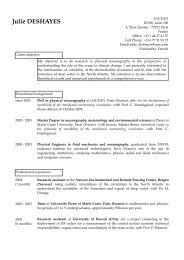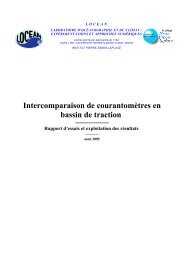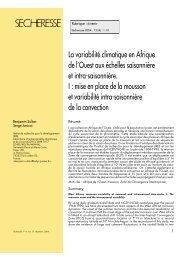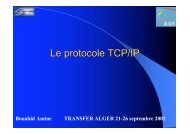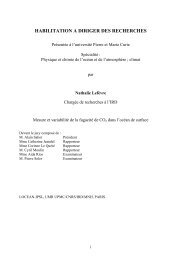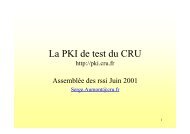PISCES biogeochemical model - NEMO
PISCES biogeochemical model - NEMO
PISCES biogeochemical model - NEMO
Create successful ePaper yourself
Turn your PDF publications into a flip-book with our unique Google optimized e-Paper software.
Table 1 – continued from previous page<br />
Parameter Units Value Description<br />
R CaCO3 – 0.2 Maximum rain ratio<br />
4 Model structure<br />
The <strong>model</strong> is being coded in mixed fortran 77/90. Even if very few capabilities of the<br />
fortran 90 are used, it will not compile with a F77-only compiler (like the gnu g77 compiler).<br />
To activate <strong>PISCES</strong>, the cpp key key trc pisces should be declared at the compilation. The<br />
<strong>biogeochemical</strong> code do not include any other cpp keys.<br />
Only the subroutines that compute the biological or chemical sources and sinks are considered<br />
to be part of <strong>PISCES</strong>. Thus, this excludes the computation of the advection-diffusion<br />
equation (the transport of the tracers), as it is not specific to <strong>PISCES</strong>. There are two types<br />
of subroutines: The initialization of the tracers and of the parameters and the computation<br />
of the various <strong>biogeochemical</strong> sources and sinks. The latter <strong>PISCES</strong> subroutines are called<br />
from within the ocean <strong>model</strong> timeloop. There is no need for them to be called at the same<br />
frequency than the computation of the advection-diffusion terms or of the dynamics. However,<br />
the biological time step should be small enough, typically one hour, to avoid major instabilities,<br />
which occur when the sources and sinks become larger than the tracer concentrations. Such<br />
instabilities could be avoided by the use of an implicite scheme, which is not implemented yet.<br />
The objective here is not to precisely detail the <strong>PISCES</strong> code but rather to list the different<br />
subroutines and to briefly describe their role. All the subroutines that compute the <strong>biogeochemical</strong><br />
sources/sinks are called from p4zprg which is then the main <strong>PISCES</strong> subroutine.<br />
p4zbio.F: Computation of the new tracer concentrations by summing up all the different<br />
sources and sinks.<br />
p4zche.F: Computation of the various chemical constants.<br />
p4zday.F: Computation of the day length.<br />
p4zdiat.F: Computation of the mortality terms of diatoms.<br />
p4zflx.F: Air-sea fluxes of CO2 and O2.<br />
p4zint.F: Time interpolation of various terms (dust deposition, growth rate, ... ).<br />
p4zlim.F: Co-limitations by the different nutrients.<br />
p4zlys.F: Calcite dissolution<br />
p4zmeso.F: Sources and sinks of mesozooplankton (mortality, grazing, ... )<br />
p4zmicro.F: Sources and sinks of microzooplankton.<br />
p4znano.F: Computation of the various mortality terms of nanophytoplankton.<br />
p4zopt.F: Optical <strong>model</strong> and computation of the euphotic depth.<br />
p4zprod.F: Growth rate of the two phytoplankton groups.<br />
p4zrem.F: Remineralization of organic matter, dissolution of biogenic silica, scavenging.<br />
13





